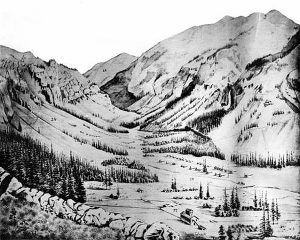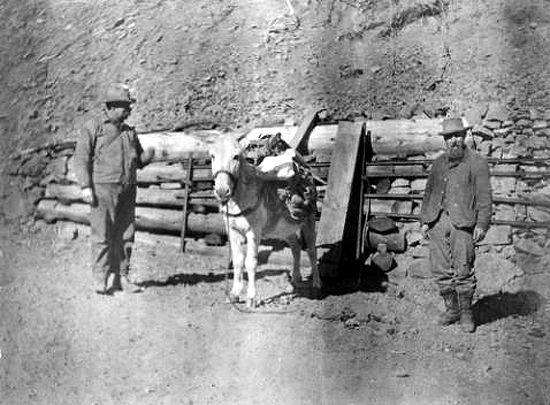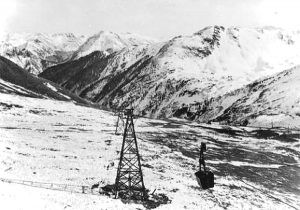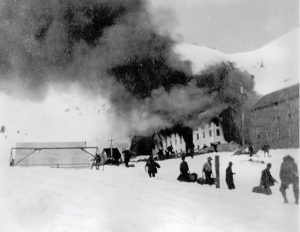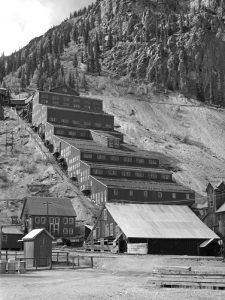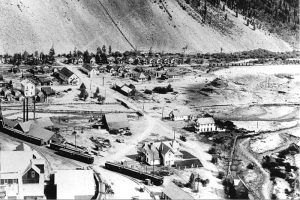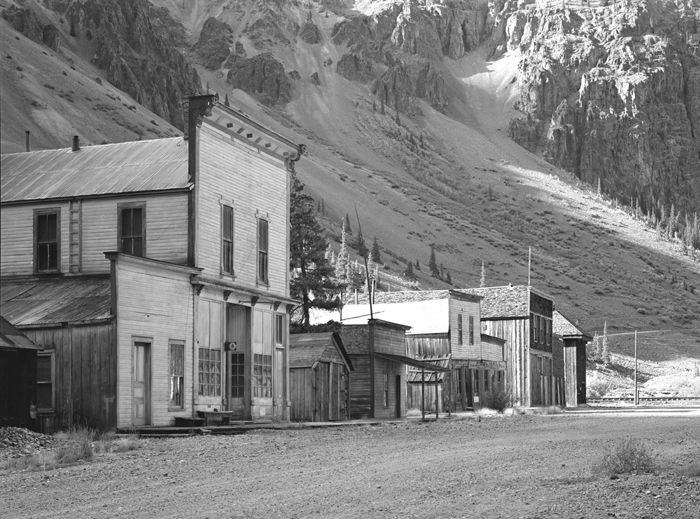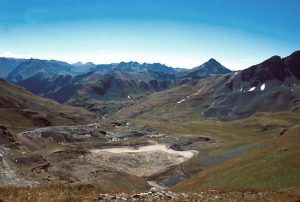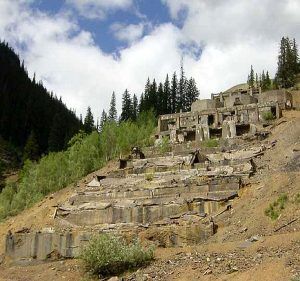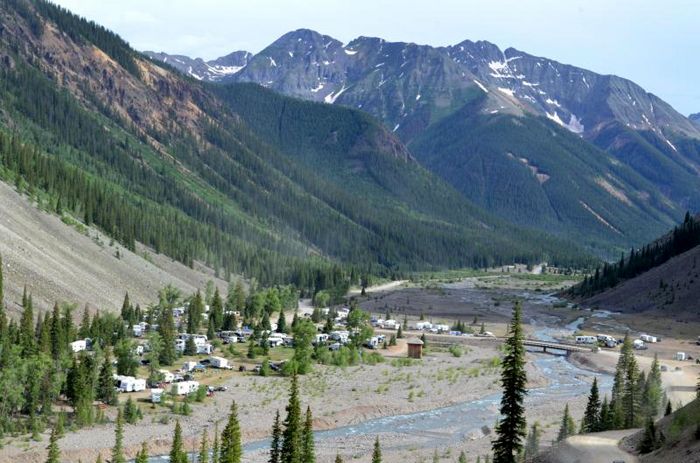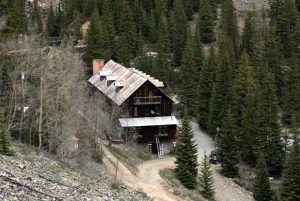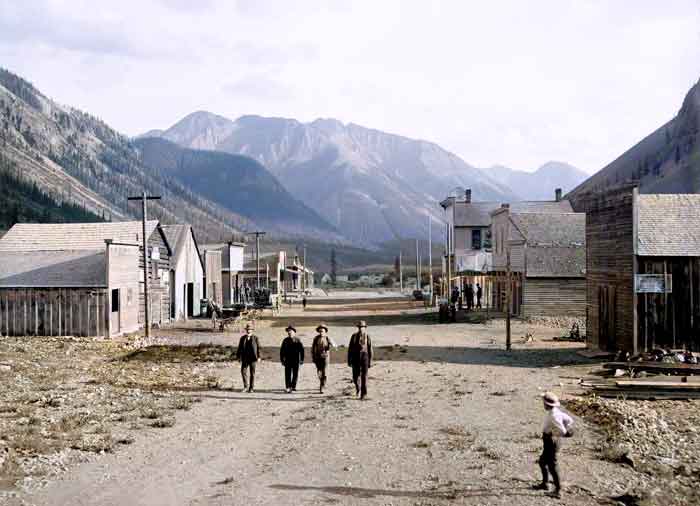
Eureka, Colorado by William Henry Jackson, 1900. Touch of color LOA.
The ghost town of Eureka, Colorado, is situated along the Animas River in San Juan County between Silverton and Animas Forks. Its longevity was primarily due to the nearby Sunnyside Mine.
The area was first explored for minerals when Captain Charles Baker led a group of miners to the San Juan Mountains in 1860. Making their camp at Baker’s Park, which is the present-day site of Silverton, they roamed the area and found placer gold in the Animas River. However, this region was the territory of the Ute Indian Tribe at this time, and the miners were forced to leave.
That changed after the Utes ceded their lands to the U.S. Government in the Brunot Treaty of 1873. That same year, prospectors returned to the area, some of whom were with the original Baker party more than a decade before.
As the men worked the hills above Eureka, several new claims were established, the largest of which became the Sunnyside Mine near Lake Emma’s shores. On the north side of the Animas River at the head of Eureka Gulch, the Sunnyside claim was made by Reuben J. McNutt and George Howard. The pair also organized the Eureka Mining District so their claims would be officially recognized.
Reuben McNutt built the first log cabin at Eureka, and before long other prospectors joined him, forming a mining camp. It took its name from the Greek phrase “I have found it!” Because of the camp’s strategic location, local speculators predicted the camp would evolve into a formal settlement, organized the Eureka Townsite Company, and platted a townsite. The town was built in the middle of two mountainsides to lessen the avalanche danger. The founders did little to promote the town or secure businesses and residents, as they, like the rest of the camp’s residents, were busy prospecting.
Reuben McNutt soon paid George Howard for his share of the Sunnyside property, and in 1874, McNutt began to develop the mine. On the other side of Hanson Peak, prospectors staked additional vein segments, one of which was the Sunnyside Extension.
A post office was established at Eureka in 1875. The next year, Milton and Emma Thompson Engleman arrived from Canon City and opened a mercantile store. Milton bought a half interest in the Sunnyside Mine from Ruben McNutt, and Emma purchased interests in the nearby George Washington and Poughkeepsie No.2 Mines. The lake near the Sunnyside Mine was named for Emma Engleman. Eureka was one of a few towns in this high altitude area to stay open through the winter.
The Miltons had little money left to develop their claims but hired several miners who began sending down ore from shallow workings. In the late 1870s, Milton wanted to develop the mines and offered interests in the property to his in-laws, Frank and Louis Thompson of Canon City, for capital. This proved to be a bad idea, as they quarreled over profits, control, and ownership, which poisoned the relationships between Milton and Emma and the Thompson family. As a result, when Milton Engleman received news that the miners had struck rich gold ore in the Sunnyside Mine, he stockpiled it instead of selling it.
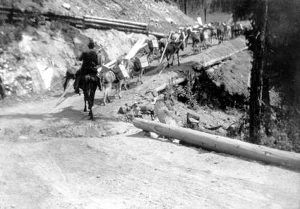
Pack trains of mules hauled the ore down from the Sunnyside Mine to Eureka and returned with supplies.
In 1883, Engleman hired John H. Terry, fresh from the mines and mills of Gilpin County, to manage his mining operations and build a mill at the Sunnyside Mine. After the ten-stamp mill at Lake Emma was complete, the Engleman’s primarily used their profits to fund their legal squabbles.
After several years, Terry was unsatisfied with the small capacity, inefficiency, and remote location of the stamp mill at Lake Emma and petitioned Milton Engleman to fund a new facility. Construction began on a new mill in 1889, about one mile west of Eureka. A small hydropower plant was installed at the mill for electricity. The Midway Mill was completed in 1890, which allowed production to increase at the mine, and in that decade, several tunnels were driven into the mountainside to reach the ore.
Terry also wanted to install a tramway, but he waited until capital reserves were replenished. In the meantime, a herd of pack animals brought the ore down the mountain to the mill. About a year later, Milton Engleman died, and the family was willing to sell. Terry bought the mine and mill and immediately began to make improvements. The silver crash of 1893 slowed Terry’s progress.
However, in 1895, Terry located a rich vein, paid off all his debts, and began buying out other investors’ sole ownership. By 1896, Terry felt financially secure enough to construct a tramway, replacing the costly mule trains to the Midway Mill. At about the same time, a group of New York investors took an interest in the Sunnyside and made Terry an offer to buy the mine for $450,000, with payments made over time and a $100,000 advance earnest money. Terry accepted the offer, and the investors immediately began to build a new mill at Eureka, overhauled the Midway Mill, and made other improvements. However, soon afterward, the miners lost the vein and, afraid to risk further loss, allowed the property to revert to Terry.
In the meantime, Otto Mears and other Colorado capitalists incorporated the Silverton Northern Railroad and began building a line from Silverton north up the Animas River. In the fall of 1895, the company utilized Otto Mears Animas Forks Toll Road as the rail bed and began construction. Workers labored in between snowstorms through the winter and finished the line to Eureka in June 1896. The railroad connected to the Denver & Rio Grande Railroad at Silverton, greatly reducing transportation costs. The railroad also offered passenger service, which allowed the miners and mill workers to live in Silverton.
Between 1896 and 1897, Terry’s miners struck the rich vein and produced so much ore that Terry had to run both the Midway Mill and the old facility on Lake Emma. With the $100,000 advance he had received from the New York investors, he resumed construction on what became known as the Eureka or Terry Mill, its tramway, and a power plant. At the mine, infrastructure was also built on Lake Emma’s shore that included boarding houses, shops, and mine buildings.
The new Eureka Mill started operations in 1899. In 1904 the Silverton Northern Railroad extended its line to Animas Forks. By this time, John Terry had groomed his two sons in the mining operations. Joseph focused on managing the mine and William the mills. When John Terry died in 1910, his sons continued.
In 1911, William Terry enlarged and refitted the Eureka Mill with a zinc ore separator, which increased its operations. Joseph managed a workforce of 90 employees producing 180 tons of ore per day, double the usual average per worker.
In 1917, the U.S. Smelting, Mining, and Refining Company (USSRMC) made a generous offer to the Terrys for the Sunnyside Mine. Forming the Sunnyside Mining & Milling Company, the Sunnyside, Washington, and Gold Prince groups were consolidated. The company made plans for yet another mill at Eureka capable of treating 500 tons per day and of finishing driving the Terry Tunnel from the mill site to undercut the vein system at great depth.
But, no sooner had they bought these mines when the company was plagued by problems, including the Sunnyside surface plant burning down, forcing the mine’s temporary closing, the influenza epidemic of 1918, avalanches, and power blackouts. However, the Sunnyside Mill was completed at Eureka, the surface plant was rebuilt, and the mine complex housed 220 workers.
During these busy construction days, Eureka was bustling as workers filled the available housing and provided business for local merchants. With the Sunnyside Mill finished in 1918, the town’s permanent population grew to about 250 people. The town boasted several boarding houses, a barbershop, J.F. Warnock’s Mercantile, McJunkin Station that sold feed and fuel, the Eureka Hotel and restaurant, A.L. Lashbaugh Livery, a doctor named William Carter, C.F. Worden’s billiard hall, as well as several mining companies and assayers.
But, in 1920, a national recession hit, and industrial metals’ price dropped to the point that operations at the Sunnyside Mine were suspended once again. In 1922, the mine reopened, 216 men were working, and 500 tons of ore were processed per day. The company then began to focus on developing its adjoining claims, and by the next year, its workforce reached 360 men.
The Great Depression caused the Sunnyside to suspend work in 1930, and it remained closed until 1937. That year, the Sunnyside Mining & Milling Company was Colorado’s largest gold producer. The accessible ore reserves were almost gone, and in 1939, the company laid off the workforce and closed the mine.
The town of Eureka dramatically suffered. It had never grown very big during its many years of existence and was comprised mostly of miners working at the Sunnyside Mill. At one point, it was described as having “the finest saloons anywhere” on its main street.
The Silverton-Eureka segment of the Silverton Northern Railroad also stopped operations in 1939. In the final years of its operation, the railroad operated a unique railcar and a favorite of the miners. The little railbus “The Casey Jones” was built in the shops at the Sunnyside Mill. It can be seen today at the San Juan Historical Society’s museum in Silverton.
The Sunnyside Mill continued to operate until 1941. The railroad removed its tracks in 1942, and the post office closed the same year. The mill facilities were sold for scrap in 1948. By this time, the town was abandoned and comprised of empty buildings
In 1959, Marcy-Shenandoah Company leased the Sunnyside from USSRMC and began to drive the American Tunnel from the Gold King Tunnel at Gladstone on Bonita Peak’s other side the Sunnyside and Washington veins under Lake Emma. But, before they made much progress, Marcy-Shenandoah sold to the Standard Metals Company. The new company continued with the plan. The ore was removed from the tunnel in Gladstone and transported by truck down to Silverton.
In 1970, the Standard Metals Company went bankrupt and stopped work at the American Tunnel, but the Washington Mining Company continued work. At this time, some of the most valuable workings were located below Lake Emma. Eventually, only 90 feet separated the lake and the underground tunnels.
During the winter of 1977-78, a fault appeared in the mine shafts under the lake and began to leak, but experts felt that the distance between the lake and mine was safe. They were wrong.
On Sunday, June 4, 1978, at approximately 6:50 p.m., the lake broke through into the mine, dumping its entire contents, estimated to have been 500 million gallons of mud and water, into the mine. The violent rush of water blew out of the two-mile-long American and one-mile long Terry Tunnels. At the American Tunnel portal at Gladstone on the other side of the mountain, water flowed from the mine in 8-10 foot waves, filled with mine timbers, equipment, and debris. A 20-ton Plymouth Locomotive parked below the main ore pass was completely flattened. Fortunately, because this accident occurred on a Sunday, the mine was closed, and no one was inside working. Had it happened on any other day, as many as 125 men would have been killed in the violent inrush of mud and water.
Afterward, the tunnels were filled to the top with mud, and the mine was closed for two years to repair the damage. Although the mine was insured for $900 million, the insurance company initially refused to pay any damages. However, after an expensive court battle, the insurance company was ordered to pay $5,500,000. But, for the Sunnyside, it would never again regain its profitable status. The mine was closed in January 1985.
Afterward, Alta Bay Mines in a joint venture with Echo Bay Mines, Ltd. leased the mine and put it back into production. Later, the mine was sold to the Sunnyside Gold Corp., a subsidiary of the Canadian mining giant Kinross Gold. The company was unsuccessful in making the mine profitable, and the mine closed for the last time in July 1991.
Over the years, the Sunnyside became Colorado’s largest operating gold mine and also produced silver, lead, copper, and zinc. It is credited with a production of more than 7 million short tons of ore over its lifespan of 118 years. In the years following the mine’s final closure, the entire mining area has been reclaimed by plugging the many miles of tunnels and other means. The cost of reclamation is more than all of the profits the mine made in its nearly 118 years of operation. Today, the overall Superfund cleanup above remains in the study stages.
Though the town of Eureka once had a number of buildings, many were taken down by the elements of nature, and others were purposely torn down to avoid taxes. Today, the old townsite is marked only by its gravel roads, one small rebuilt building, and the old Sunnyside Mill’s foundation on the hillside. It is now home to the Eureka Campground.
The Sunnyside Mine site can be reached by traveling about 1/2 mile north on Co Rd 2 and taking a sharp left on Co Rd 25 for 3.5 miles. Only old mine foundations exist today, and there is an empty “bowl” where Lake Emma once stood.
Eureka is located about 7.5 miles northeast of Silverton on County Road 2. The road can be traveled by any vehicle in good weather. Beyond Eureka, it is just 4.2 miles to Animas Forks, which is the access to the Alpine Loop Backcountry Byway. The byway, which requires a 4-wheel drive high-clearance vehicle, offers stunning views, numerous mining remains, and several ghost towns along the 65-mile loop.
Just about a half-mile north of Eureka is a side road that veers to the right to the Eureka Lodge. This 1929 boardinghouse was once part of the Martin Mining Complex and is now listed on the National Register of Historic Places. It now serves as a lodging facility for groups, weddings, family reunions, and retreats.
©Kathy Weiser-Alexander, updated May 2021.
Also See:
Silverton – High in the San Juans
Silverton Road to the Alpine Loop
Sources:
Friends of Mineralogy
Historic Mining Resources of San Juan County
New Mexico Bureau of Geology & Mineral Resources
The Silverton Railroads

